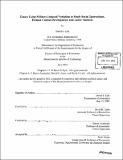| dc.contributor.advisor | David H. Autor and Daron Acemoglu. | en_US |
| dc.contributor.author | Lyle, David S. (David Stephen), 1971- | en_US |
| dc.contributor.other | Massachusetts Institute of Technology. Dept. of Economics. | en_US |
| dc.date.accessioned | 2005-05-19T15:18:17Z | |
| dc.date.available | 2005-05-19T15:18:17Z | |
| dc.date.copyright | 2003 | en_US |
| dc.date.issued | 2003 | en_US |
| dc.identifier.uri | http://hdl.handle.net/1721.1/16923 | |
| dc.description | Thesis (Ph. D.)--Massachusetts Institute of Technology, Dept. of Economics, 2003. | en_US |
| dc.description | Includes bibliographical references (p. 167-178). | en_US |
| dc.description | This electronic version was submitted by the student author. The certified thesis is available in the Institute Archives and Special Collections. | en_US |
| dc.description.abstract | This dissertation consists of four empirical studies, each using military-induced variation to examine various aspects of human capital production and the U.S. labor market. The first two chapters study the effects of social interactions on human capital development at the United States Military Academy where social groups are randomly assigned. Chapter 1 highlights the empirical difficulties associated with identifying social effects and contains evidence suggesting that occurrences common to a social group may account for a large part of social group correlations found in many studies. While models that address these identification concerns provide little evidence of social effects in academic performance, there is evidence that both peers and role models influence other dimensions of human capital that have important labor market consequences. Chapter 2 builds on the previous chapter by investigating whether peers are complements or substitutes in the production of human capital at West Point. Heterogeneity in peer group composition can provide evidence for the degree of substitutability between peers. Estimates reveal that more heterogeneous peer groups have positive effects on individual grades. This suggests that peers serve as substitutes, and therefore, mixing cadets by ability is optimal for the efficient production of education at West Point. Chapter 3 evaluates the impact of military-induced parental absences and household relocations on children's educational attainment. Estimates indicate that parental absences adversely affect children's test scores by a tenth of a standard deviation and frequent household relocations also have modest negative effects of similar magnitude. Chapter 4 investigates the effects of female labor supply on the U.S. wage structure at mid-century. | en_US |
| dc.description.abstract | (cont.) As men mobilized for war in the 1940s, women were drawn into the workforce. In states with greater mobilization rates, women worked more after the War and in 1950, although not in 1940. Estimates indicate that increases in female labor supply lower female and male wages, and generally increase the college premium and male wage inequality. Finally, at mid-century, women were closer substitutes to high school graduate and relatively low-skill males, but not to those with the lowest skills. | en_US |
| dc.description.statementofresponsibility | by David S. Lyle. | en_US |
| dc.format.extent | 178 p. | en_US |
| dc.format.extent | 9289265 bytes | |
| dc.format.extent | 16181141 bytes | |
| dc.format.mimetype | application/pdf | |
| dc.format.mimetype | application/pdf | |
| dc.language.iso | eng | en_US |
| dc.publisher | Massachusetts Institute of Technology | en_US |
| dc.rights | M.I.T. theses are protected by copyright. They may be viewed from this source for any purpose, but reproduction or distribution in any format is prohibited without written permission. See provided URL for inquiries about permission. | en_US |
| dc.rights.uri | http://dspace.mit.edu/handle/1721.1/7582 | |
| dc.subject | Economics. | en_US |
| dc.title | Essays using military-induced variation to study social interactions, human capital development, and labor markets | en_US |
| dc.type | Thesis | en_US |
| dc.description.degree | Ph.D. | en_US |
| dc.contributor.department | Massachusetts Institute of Technology. Department of Economics | |
| dc.identifier.oclc | 52873364 | en_US |
